In recent years illustration has evolved far beyond traditional child’s play. The classic art form that many people associate with children’s books actually has serious B2B benefits.
More and more, illustration has become a focus of company web pages, getting more unique and colorful with each year. Illustrations can be a powerful tool in brand storytelling and avoiding the potential pitfall of cheesy stock alternatives. They can provide your customers with an approachable introduction to a brand, while also reinforcing design styles or colors key to your visual identity. For many B2B companies, illustrations have become an essential component of customer-facing imagery.
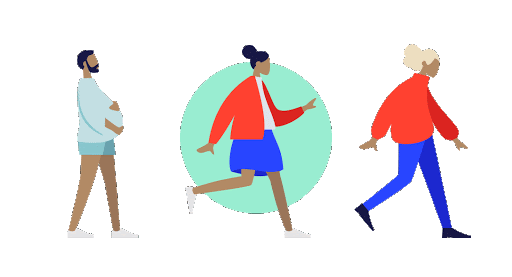
Here at Bluetext, we see a variety of purposeful illustration styles. Two of the main objectives for B2B companies seeking illustration is to visually describe abstract products, or depict meaningful customer experiences. For many industries, such as tech or cybersecurity, showing literal subjects or end-user experience is not possible through photography, therefore, illustration is an ideal solution.
Below are some of our favorite illustration themes used to take clients’ business goals to new heights.
Flat
There’s no reason to shy away from simplicity! Flat illustrations have been a huge trend in 2020, with many major companies including GoDaddy, Mailchimp, and Slack implementing them into their brand designs. This illustration style is most often used to depict people or experiences. Stock photography tends to favor extremely generic scenarios, or let’s face it, painfully boring subjects. When your business wants to highlight a specific experience or incorporate as much branded detail as possible, custom art may be the way to go. Illustrative styles offer far more flexibility and adaptation, without falling flat.
Bluetext produced flat illustration styles for Centauri’s employee engagement campaigns to depict unique company events and contests that stock photos could not.
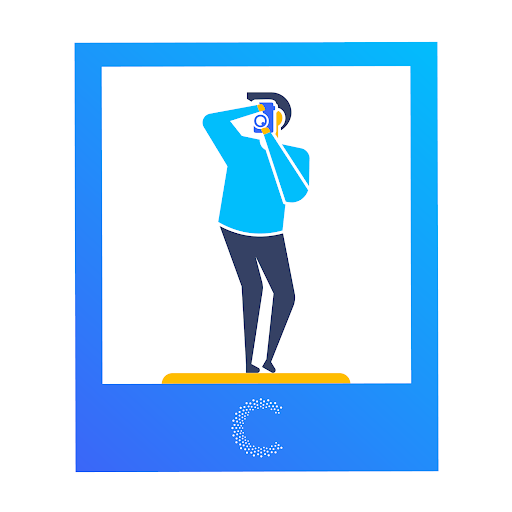
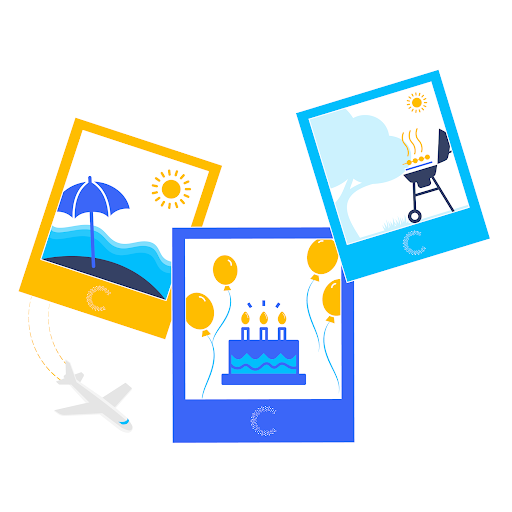
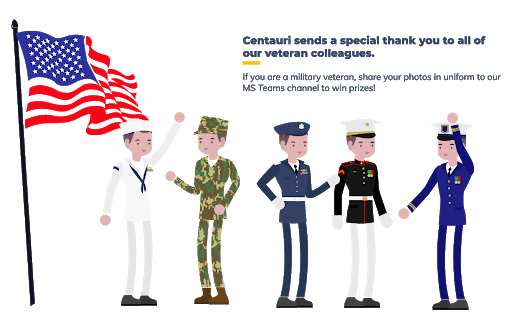
3-Dimensional
Bluetext’s work for Cvent brought custom illustrations to life in a 3D animated video. Intended to immerse the viewer with a preview of the event experience, graphic designers and animators transformed human illustration into a realistic simulation. With this stunning visual design, Cvent was able to digitally communicate their in-person experience to remote viewers and translate their business value in the most powerful manner.
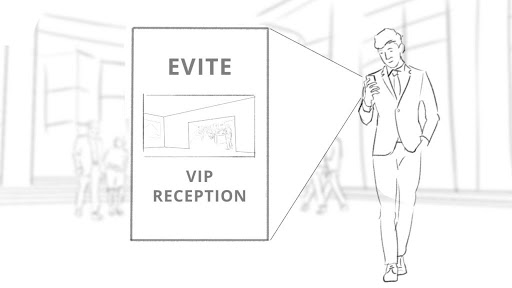

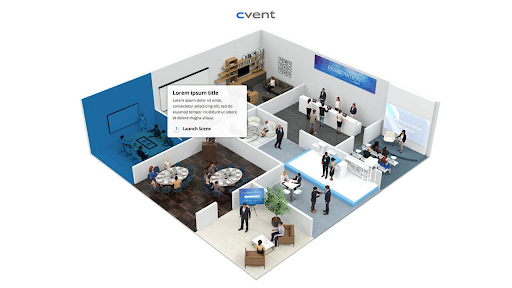
Sketch
Bluetext’s work for GMAC, Graduate Management Admissions Council, promotes graduate school admissions in an approachable and digestible manner. Stretch illustrations were used in the revamped CallingAllOptimists.com campaign to inspire people motivated to improve their future opportunities into action. Juxtaposing a serious life decision and often anxiety heavy admissions process with a uniquely, optimistic brand identity captures both the courage and the celebration of the end-user. Illustrative styles complemented real photography to provide a snapshot of the user, decision factors, and end result.

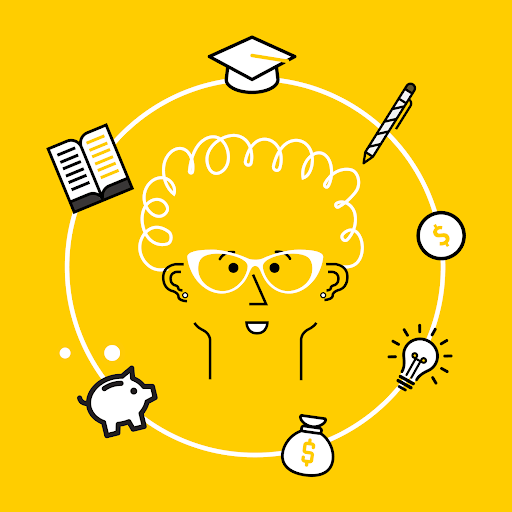
Monochromatic Gradient
In another successful campaign for GMAC, Bluetext designed custom humanistic illustrations to represent user personas. In awareness of a wide breadth of audience targets, the campaign opted to show a variety of potential applicants in a range of career stages. To resonate with a potential applicant, it was key that they could imagine themselves pursuing a graduate degree. To avoid isolating any potential audience members, Bluetext’s custom illustrations avoided biases of race or ethnicity by showing monochromatic styling of men and women in post-grad, young professionals, and even in established careers.



Product Illustration
Another top use case for illustrations is product depictions. Especially in service-based or digital industries, it can be a challenge to accurately depict what you’re selling to customers. Bluetext client RevBits, a cybersecurity software and service provider, overcame this obstacle with branded product illustrations. With a complex product lifecycle, visuals helped conceptualize their cybersecurity offerings in a clean and user-friendly format. Especially on webpages, product illustrations were an ideal way to communicate offerings to users scanning a webpage and without the time or desire to read long paragraphs of text. The illustrations utilized key brand elements such as color palettes and iconography to maintain a consistent brand experience throughout the website.



Digital illustrations are catching a new wave of excitement from companies across all industries. With an ever-expanding range of use cases and applications, we predict this will quickly become one of the most effective ways for B2C or B2B companies to start a more emotional conversation with users. With the rise of personalization and hyper-targeting, establishing warmer and more “human” relationships with clients and customers is a proven way to strengthen loyalty and improve overall ROI.
Interested in exploring the potential of a rebrand (or illustrations!) for your business? Contact Bluetext today.
Welcome to 2020, a year of new normals, routines, and best of all, new logos! The logo design trends in 2020 thus far have been an intriguing remix of new and old. Logos have taken a trip back in time to a variety of eras, while also remixing modern styles. We’ve seen the gamut of design trends; from neon 80’s juxtaposed against inky, to futuristic 3D gradients and custom animation.
The key theme of 2020 logo design has been a digital-first focus. Many brands have modernized their logos for optimal web and mobile displays. For example, the popular gradient trend has evolved and merged with 3D design —a perfect fit for our smartphone society.
3D Gradients
Gradients are a unique way to blend any group of colors into a dynamic spectrum that exudes life and energy. Gone are the stark striped color transitions, as some brands have opted for a more subtle and gradual shift. This year, designers will give rise to the newest evolution of gradients creating depth and 3D effects in logos. Other top branding agencies are experimenting with new trends such as tapered gradients—ones that come to a central point and actually emphasize the contrast between their colors.
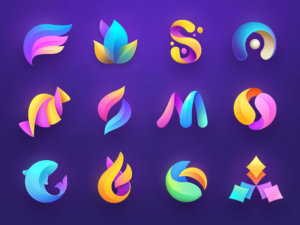
80’s Retro
Don’t thrift away your 80’s style just yet, because some fads never go out of fashion. Enough time has finally passed for all things 80’s to be cool again: video games, pop music, and the rebel attitude associated with them. In 2020, logo design agencies expect to see a resurgence of throwback logos accented with chrome, neon, and a lot of digital pixels. These styles give a nod to the old-school tech that preceded the glowing iPhone and laptop screens our eyes are glued to today. Nostalgic marketing has made a huge comeback in recent years, necessitating a cool, retro logo to accompany any throwback campaign. Throwback logos are popular because they capitalize on consumers’ nostalgia of old-school 80s tech, which is widely known to be retro, cool, and most importantly, collectible. Some logos reference nostalgic 80’s items by literally depicting the old school cassette tapes, arcade games, etc. Others embrace this trend with 80’s typography and design trends, like GV’s logo for LI Mowz.
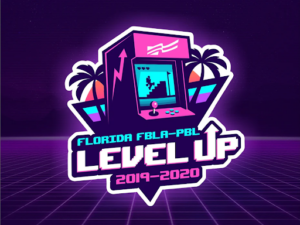
Ultra Thin Lines
In 2020, high definition is leaving its mark on logo design. Designers push the envelope with extremely delicate lines, creating effects that can only work in the digital media. With extremely detailed linear patterns, logos began to feel ethereal and surreal — much like the original perception of radio and transmission media. With the new ability (and COVID necessity) for some brands to exist exclusively online, previous print limitations are eliminated. In an age of high-resolution screens and defined displays, complex line design makes classic logos seem elementary and easily reproducible.
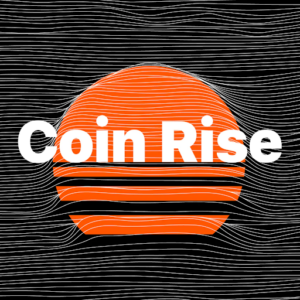
Multi-Layered
2020 has been all about complexity! Logos are going deeper than ever before using artfully layered color systems. Especially with new digital affordances, designers are reverting flat and semi-flat designs to build depth through color layering. While shapes and colors remain simple, their relationship has intensified. By adding additional layers, designers create complex logos with highlights, shadows, and overlapping colors to communicate the brand brands. Especially on digital screens, the ability to create three-dimensional effects creates a unique, almost tactile experience.

Animated Logos
Top design agencies have been producing logo animation for some time now, but in 2020 we’ve seen more detailed and innovative plays on animation. Previous logos have been limited to simple movement, but over the years technology has allowed for more intricate and purposeful movement. Especially with a growing digital audience, animated logos can be more eye-catching and practical to the brand story. A popular 2020 logo design trend has been the blending of 2D and 3D animation or logos with multiple moving parts. These complex logo animations aim to take the viewer on a journey and tell a story. With lots of details to look at, the viewer looks at these logos longer than they’d look at a more simple logo animation and can potentially find something new they like about it every time they see it again.
The move toward animated logos comes from a similar place as the tapered gradient logos trend: when you’re designing for screens, there’s a whole lot more you can do as opposed to when you’re designing for print.

The logo design trends for 2020 will continue to build on everything designers have been exploring in the last few years, while also taking the design in directions that are totally new, totally fresh, totally right for an all-new decade. Let’s take a look at the top logo design trends that are already defining 2020.
A fantastical idea, a powerful pitch, and energetic enthusiasm from all sides of SonicWall stakeholders. Only one task remaining: execution of the over the top Boundless Campaign.
SonicWall came to Bluetext with one main objective: bring their Boundless Cybersecurity campaign to life. As such, the SonicWall team needed creative assistance in bringing the campaign visuals up to par with their brand value. The Bluetext team was asked an age-old question of B2B companies, “How can we make this campaign memorable?”
Especially in the saturated cybersecurity market, it can be challenging to differentiate from strong competitors and help visual abstract brand promises. So the Bluetext team presented a thought-provoking approach to the campaign’s new creative and campaign taglines.
“When cyber threats are limitless, your defenses must be Boundless.” Break free with SonicWall Boundless Cybersecurity.
To communicate and contextualize this message, Bluetext presented a creative direction that would showcase the end-user in a gravity-free surrealist state, which literally breaks free of the constraint of cyber threat. The creative would be scaled across main industry verticals in order to personalize and target advertisements. The idea was over the top, innovative, and ambitious but well-received with client buy-in. Next came the challenge of execution, which was overcome using a custom photoshoot complete with realistic costumes, props, and even a trampoline. In order to achieve the effect of floating in an anti-gravity state, professional ballet dancers were hired to jump on the trampolines. Photographers captured the dancers posing mid-air, then flipped the photo 180°.

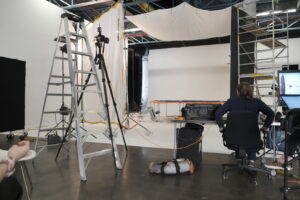

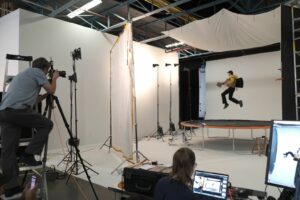
Once the in action shots were captured, the images were edited to remove the backgrounds and impose on industry-specific scenes. Related props were also imposed onto background images to make the scene appear as if person and objects had been magically released from the pull of gravity while the world remains grounded around them.

 At the time of the new Homepage and campaign landing page launch, these static images truly came to life with a subtle parallaxing effect.
At the time of the new Homepage and campaign landing page launch, these static images truly came to life with a subtle parallaxing effect.
To drive users to these newly premiered pages, SonicWall needed eye-catching advertisements that viewers would — no pun intended — gravitate to. Bluetext designed a variety of verticalized static banner ads and further animations to drive page traffic.
The recent COVID-19 outbreak has had ripple effects across almost every industry. Around the world, the global pandemic has altered the way we live, socialize and even conduct business. In this unprecedented scenario clouded with uncertainty we all, especially digital marketers, are wondering: What needs to change? And how drastically?
When it comes to search engine optimization strategies, digital marketing and content agencies are continually researching the latest trends and evolving best practices. In the current environment, the role of a top digital marketing agency is to keep a pulse on the present, while also looking forward to strategies that will drive long-term success. Here at Bluetext, our digital marketing analysts are harnessing a variety of tactics to support overall business goals and serve users the best we can during these uncertain times. Check out the top ways we’ve been monitoring and optimizing around current events.
Strength in Numbers
When in doubt, trust the data! Using top marketing analytical tools, such as SEMRush and Moz, one can track the aggregate behavior of online users. Gathering the most up to date data can be tricky, so don’t do it alone. The more expertise and tools, the better. Trust a marketing analytics agency to help break down the numbers into a comprehensible story of website traffic. Use professional tools, such as Google Analytics and Google Search Console, to monitor the recent fluctuations in your page traffic. Do a keyword analysis of your current keyword list to see if search volume has shifted. Google Trends page is a great tool to identify emerging patterns. Are there new phrases your customers are searching for? If the language has evolved, so should your SEO strategy. If you have chatbots for customer service transcripts, these can provide valuable insight into current needs.
In short, the data doesn’t lie. Businesses need to understand search traffic shifts to get as clear as possible a picture into whether to pivot your SEO strategy or not.

Content is King — Still
Ultimately any changes to your SEO strategy should be driven by your unique business needs. For example, a brick and mortar store will need to cater to how they can serve customers at home. If your business was already available online, you may be experiencing altered user behavior as people spend more time at home and online. Every business should ask: “Is the content relevant to current needs?” Your messages may need to shift in sensitivity to the current environment. A complete overhaul is not necessary, nor appropriate. However, if there are opportunities to generate new content that supports your users in a unique time, do so. And if your business is considered essential or has been significantly impacted, you should create a dedicated page to capture all relevant coronavirus traffic. Keep the page simple, focused and sensitive. Don’t try to provide the latest breaking news, but exactly what and how your company is doing. If your business has been minimally affected, perhaps there is an opportunity to contribute to emerging conversations. Exploding Topics is a valuable tool for up-to-date trends across search engines and social media mentions. At the end of the day, users are seeking timely and accurate information now and long after the dust has settled on this pandemic.
 Optimize Often
Optimize Often
Search engine optimization is never a “one and done” task. Any digital marketing strategy requires upkeep as is the nature of the evolving industry. Now, more than ever, flexibility is paramount to staying afloat. Be proactive, be vigilant. SEO strategy will need re-evaluation in the upcoming weeks and months. No one can predict how long the pandemic will last so you must be ready to pivot to any new or resurging customer needs.
In an unpredictable environment, one thing is certain: this is our new (remote) reality. Don’t expect old strategies to work as they once did, and don’t expect this shift to “blow over soon”. Your business should be prepared to remain relevant now more than ever. There will likely be long term implications in behaviors and business operations. Get behind the shifts now and flex your agility. It will pay off in your long term business health.
If you’re looking to partner with an agency to pivot your SEO strategy, let us know.
As of late, communications have been drastically changing, and companies have had to adapt quickly and swiftly to accommodate the current COVID-19 environment. It is a new and unprecedented scenario, forcing flexibility and fast thinking to all aspects of the business. As work-from-home policies and entirely virtual communications surge, recruitment strategies have been greatly impacted. How a company reacts to this digital shift and adapts various business models is crucial to future success following the return to normalcy.
Improving Remote Recruiting & On-Boarding
Learning how to better recruit and virtually onboard, not only during COVID-19 but throughout a company’s entire lifespan, is essential. It demonstrates your company’s ability to stay flexible, proactive, and conform to different comfort levels.

Have a Convincing & Personalized Careers Page
Virtual recruiting isn’t a novel idea. Companies have been trying to actively attract new talent online for years. However, in order to get a great pool of new hires, you need one thing: an outstanding career section on your website. Your career section is the portal for all potential new employees to investigate your company, culture, benefits, growth opportunities, and what you are all about. This is your first impression to prospective employees, who are most likely browsing opportunities at multiple companies! The main mission of a career section is to make the biggest impact in the shortest amount of time. How do you do this? With the proper targeting.
Proper targeting isn’t all about spending large sums of money on paid media. It’s important to utilize your current resources and current employees to create a lasting campaign. Centauri, a technology-driven company providing high-end, creative software and engineering solutions to critical national security missions, came to Bluetext wanting a recruitment-focused campaign. Looking at the diversity in the age, specialty, race, gender and backgrounds of current employees, Bluetext created a range of different personas. Backtracking to Marketing 101, persona creation is a critical step in marketing to the right audience. It’s crucial to know a user’s specific goals, interests, and motivations. For example, a young college graduate student will have different goals versus an experienced middle-aged military veteran. By creating personas, potential employees are able to connect more with someone that closely resembles them. For proper targeting, personalization is key. The career section should play into all personas, create hyper-specific content and show the user relevant jobs pertaining to them. Sound like a lot of legwork? Digital marketing agencies, such as Bluetext, are experienced and proficient in persona creation and targeting strategies.
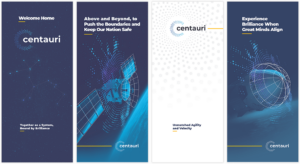
Leverage Alumni Networks
Another great way to better recruit qualified candidates is to create an Alumni Network. This can take many forms, with the most popular being an informal social media group harnessing Facebook or Linkedin). This creates a space for alumni to connect with others, share thoughts, and best of all, provide valuable leads. Not only are you getting free referral lead generation, you nurture an excellent relationship with the company even after the employee has left. It creates brand ambassadors who are constantly promoting your company in a positive light, possible future business partners, and topnotch re-hires.
Institute a Welcoming Virtual Onboarding Process
While virtual recruiting was surging in popularity even before COVID-19, virtual onboarding is relatively new. Companies like Amazon have already begun to virtually onboard thousands of new hires to keep up with higher demands. The biggest concern for most employers is exactly how to bring a newly-hired employee into the company and properly integrate them.
Onboarding is the first time a new employee gets a true first impression of the company in action. Maybe new hires came into the office to interview, but this is the real introduction to the nit and grit of day to day tasks. The first day typically involves numerous face-to-face meetings and handshakes–both no longer possible amidst the COVID pandemic. When virtually onboarding, It’s important to utilize scheduling software, internal communication platforms, and video conferencing tools in order to keep the initial introductory phase as personal, engaged, and genuine as possible. This is especially important for one-on-one meetings with direct managers.

Being able to leverage current new-hire learning processes virtually is a huge focus as well in the current environment. Do your new hires get a “Welcome Binder?” Replace that with a consolidated folder filled with the online version. Do you typically run through various Powerpoints with your new hires? Think about translating those into short, educational shared videos. Are there various informational sessions for new hires? Leverage video conferencing and screen sharing tools. Translating your in-person process to online can be done by almost anyone. In fact, the more people involved the better! Have multiple employees help create onboarding videos so that new hires get introduced to a wider breadth of the company.
The main goal of your virtual onboarding should be to make the new hire feel comfortable. Make sure to over-communicate and offer assistance as much as needed. Be sure they are understanding expectations laid out and asking questions when they feel confused. Make sure they get proper introductions, are included in virtual activities, and let them truly shine.
Virtual recruiting and onboarding are of utmost importance right now, but companies will benefit by taking advantage of these now and implementing these processes for all future recruiting and onboarding processes and the industry shifts. At Bluetext, there is no limit to the amount of success we can help you achieve. To learn more about our processes and to see our work, check out our case studies.
Ready to partner with Bluetext to achieve your marketing goals? Schedule a call with us today.
The creative industry is abuzz with excitement, fears and anticipation of what recent AI developments may bring. Many generative AI tools have emerged in the marketplace, each promising their own unique advantages. As explored in our previous post, generative AI tools can be a powerful aide to the ideation process. So how do you go about using generative AI to enhance the ideation efforts? For a creative, visual output, text-to-image AI tools will utilize an input-output format. Meaning, the generative AI models are trained to follow instructions in a prompt provided and generate an image based on entered keywords, styles, and more. Bluetext recently leveraged Midjourney to explore its capabilities.
Our Challenge
Bluetext was sought out by a financial software company looking to create an attention-grabbing go-to-market campaign that would improve overall awareness of the unified brand and increase in qualified leads. The campaign needed to be creative and impactful. Visuals needed to be striking enough to capture the attention of their potential customers and differentiate them from their competitors, and compelling enough to effectively address the pain points of their target audience.
One of the ideas that arose during the campaign conception process was to show a hyperbolic demonstration of one of the target audience’s biggest challenges – that dated technology can hold them back, literally. To help with the ideation process and find inspiration for the campaign visuals, Bluetext turned to MidJourney.
Ideation Process:
The process involved a delicate game of trial and error — entering prompts and making tweaks to the keywords, information and instructions we provided in order to try and generate a range of visuals that may fit with the campaign strategy and vision. Here’s a sample of what we tried:

Base Prompt: “Business man, technology holding back”

Refined Prompt: “Realistic, sideview of a businessman sitting in a chair in the office, shirt is connected to printer cables behind him, he is being pulled back from his desk by cables, 8k”
Refined Prompt: “Ultra realistic photo, side view of business man sitting at desk working on a computer, behind him are more computers, wires from the computers behind him are attached to his shirt pulling him away from his desk”

Variations on Selected Image: “Ultra realistic photo, side view of business man sitting at desk working on a computer, behind him are more computers, wires from the computers behind him are attached to his shirt pulling him away from his desk”

Prompt:”Side view photo, young business man looking at computer, wires from other computers behind him are wrapped around his torso, tied to chair, hands on desk, wires tight and look like they are pulling guy away from desk”

Prompt: “Ultra photoreal, ultra-detailed, side view, businessman sitting at desk working on computer, computers behind man have wires reaching out and wrapping around the man, tangling and tying him to chair”

Prompt: “Photorealistic, ultra detailed, side view, young businessman sitting at desk looking at computer, more computers are behind man and have wires reaching out and wrapping around the man, man is tied to chair with the wires, man looks frustrated”
[insert visuals and corresponding prompts]
Outcomes & lessons learned:
As you can see from the examples above, this technology is by no means perfect. After hours of iterating, we struggled to get the visual output to match exactly what we were trying to convey.
This brings us to a few key takeaways. Generative AI tools have very real limitations, like in the realism of art (see the human appendages below) and in output control. Also, while generative AI is a great starting place for brainstorming, it will likely not produce your final product. It is best used as an ideation-stage tool to help get your creative juices flowing.



As demonstrated above, generative AI tools will produce results, but they may not always be exactly what you are looking for. That is why it is important to set realistic expectations for the AI model’s capabilities and refine your prompt writing to produce successful outcomes. The best prompt writing process to follow depends on the specific generative AI tool being used and the desired outcome, but general tips can help improve the quality of the output generated by the AI model:
- Be clear and specific about the desired outcome or task. This helps ensure that the AI model understands what it is being asked to do and produces relevant output. For example, if you are using an AI model to generate a creative writing piece, clearly specify the genre, tone, and other relevant details.
- Provide the AI model with as much, high-quality input data as possible. The quality of the input data can significantly affect the output generated by the AI model, so it is essential to provide diverse and representative input information that aligns with the desired outcome.
- Experiment with different prompts and input data to identify which ones produce the best results. The quality of the output generated by the model can vary depending on the information and instructions provided, so testing out a variety of inputs can help increase your chances of receiving a relevant and accurate response.
- Review the output carefully. While AI models can generate impressive output, they are not perfect, and may require some editing to meet the desired standards.
Interested in head-turning campaign creative for your business? Get in touch with Bluetext to learn how technology-powered creatives can bring your vision to life.
It’s no secret that Conversational AI has become a familiar part of our everyday lives. With the rise of virtual assistants like Siri, Alexa, and Google Assistant, the way that we interact with technology has become more personalized than ever before. But the benefits of AI go far beyond simple voice commands and smart speakers; Conversational AI is a tool that can optimize efficiency in a wide variety of industries and contexts, from customer service to healthcare to education.
Outcomes & Benefits From Business Process Perspective
Conversational AI systems, also known as chatbots or virtual assistants, are designed to provide personalized communication with users. For some, their first thought of AI might include Siri announcing the weather, or Alexa updating their shopping list. However, what many people don’t realize is that the capabilities of Conversation AI go much deeper and can be the key to optimizing business operations. AI can improve the efficiency, effectiveness, and personalization of communication with customers, employees, and stakeholders.
Industry Index
As AI technology continues to advance, businesses across a broad range of industries are discovering innovative ways to integrate it into their operations to enhance processes and productivity. As market offerings of AI continue to expand, almost every industry is finding new and unexpected ways to leverage new technologies. The capabilities of AI are limitless; here are just a few of the most unique and surprising real-world use cases of AI.

- Real Estate: Online real estate platform Compass is using AI to create custom listing videos for clients in just a few clicks. Their AI-powered phrase recognition technology is able to pull out key listing attributes and pair them with the best suited images, generating a professional and personalized video for potential buyers.
- Construction: AI produces a multitude of benefits for construction and manufacturing companies. From increasing safety to optimizing work schedules, AI in the construction industry has proven its value. Buildots, a construction tech company, has created a wearable 360-degree camera that uses AI to monitor construction sites by detecting schedule deviations, incorrect installations, and unsafe conditions.
- Financial: According to Insider Intelligence’s AI in Banking report, 80% of banks are aware of the benefits of Conversational AI in their industry. It enables frictionless, 24/7 customer interactions, lowers the possibility of human error, and increases customer satisfaction for a multitude of use cases, including but not limited to bank transfers, closing and opening accounts, card replacements, and password resets. Aside from these advantages, AI in financial settings can also identify variations in transaction patterns and other warning signs that could indicate fraud.
- Media & Telecommunications: Businesses can leverage AI to monitor and analyze audio and video data to report findings in real time. Call centers, for example, can utilize AI-enabled solutions to transcribe and document phone conversations, which can then be analyzed to detect customer sentiment, identify key topics and issues, and mine discrepancies. Additionally, AI in customer care centers can help bolster real human interaction by managing mundane tasks and helping find a solution in a fraction of the time that it would take a real person.
- Healthcare: AI-powered chatbots can help patients schedule appointments, send reminders, and provide information about appointment logistics. Conversational AI tech can also provide patients with information on health conditions, treatment options, and self-care instructions.
- Higher Education: By leveraging conversational AI, educational institutions can provide more personalized and efficient learning experiences, improve student outcomes, and reduce the workload on teachers and administrative staff. One way that AI can help to automate tasks for educators is by providing automated assessment and feedback on student assignments, while also identifying areas for improvement and recommending learning resources.
Power of Amelia AI
Amelia AI, Bluetext’s partner, and client of brand services, has established itself as an enterprise leader in Trusted AI by consistently providing reliable and secure AI solutions. Amelia uses a combination of natural language processing (NLP), machine learning, and cognitive reasoning to understand the intent of user requests and provide relevant responses. Unlike traditional chatbots, Amelia learns from every interaction, evolving and improving its understanding and responses over time in order to better all future interactions.
One of the key advantages of Amelia is its ability to integrate with existing enterprise systems, enabling seamless communication across departments and workflows. Amelia can also be deployed across multiple channels, such as web, mobile, and voice, providing a consistent and personalized experience to end users. Amelia is able to optimize business efficiency across all types of industries by streamlining processes and elevating customer service and experience. For example, Amelia AI was hired to fill the role of Virtual Engineer for CGI clients, specifically handling incident resolution and ticket management. Through the engagement, Amelia helped CGI reduce client outages by 30 percent.

Amelia also paired up with Visionworks to transform their customer experience operations by operationalizing the process to schedule eye exam appointments, provide order status updates, answer store-related questions, and more. Amelia represents a significant step forward in the development of conversational AI, providing organizations with a powerful tool to improve customer engagement, reduce costs, and drive innovation.
The Future of AI Optimization
As natural language processing and machine learning algorithms improve, AI technology will become increasingly adept at understanding and responding to human speech in more complex and nuanced ways. Companies that have successfully incorporated AI into their business operations have proven that they can automate routine tasks, reduce operational costs, and enhance customer satisfaction and retention. Beyond improving processes, AI technology can lend valuable insights into customer behavior and preferences, ultimately improving and personalizing their experience. With the potential to transform nearly every aspect of business, it’s no wonder that AI is becoming an increasingly popular technology for companies to adopt.
In recent years, the field of artificial intelligence (AI) has made incredible strides in developing sophisticated algorithms and models capable of producing new content, ideas, and even entire works of art. This technology, known as generative AI, works by using machine learning algorithms to generate new content based on the patterns it has learned from massive stores of data. Generative AI tools are quickly gaining traction in the world of marketing, with brands and creatives around the world starting to experiment with the technology to bring their visions to life.
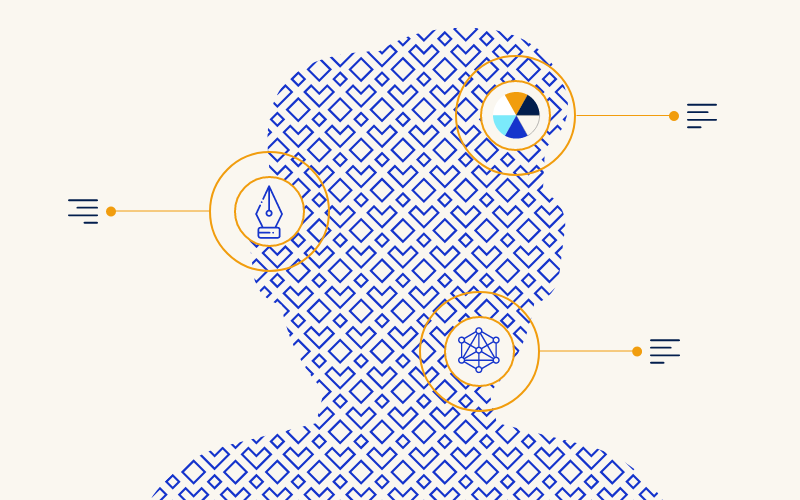
With generative AI tools, marketers can jumpstart their design and creative ideation process, experiment with new formats and ideas, and even help ensure their messaging resonates in the marketplace. In this blog, we will delve into the world of generative AI and explore the creative possibilities and opportunities that this technology offers.
Generative AI Tools & Process
From design to copywriting, generative AI can significantly enhance traditional ideation processes and has made it easier to create high-quality content quickly. It’s well known in creative fields the ideation process is the toughest hurdle, once an idea is conceived the execution flows naturally. So the thought of removing the age-old writer’s block or creative slump is game-changing for creative minds across every medium. However, while A.I. can produce impressive results, it’s by no means a magic wand. The tools require a great deal of human input and forethought to guide the AI algorithms and improve the overall quality of the output. In this way, generative AI is a powerful sidekick to humans, rather than a replacement.
So, how do you go about using generative AI in your ideation efforts, and what tools are available to you? Well, that answer depends on what you are trying to accomplish. If you are looking for some sort of written output, you will want to use a generative AI tool that uses natural language processing to generate a text response. If you are looking for a creative, visual output, you’ll want to use a text-to-image AI tool. Regardless, these tools will utilize an input-output format. Meaning, the generative AI models are trained to follow instructions in a prompt provided by the user and generate a human-like response in the form of a detailed, written answer or image.
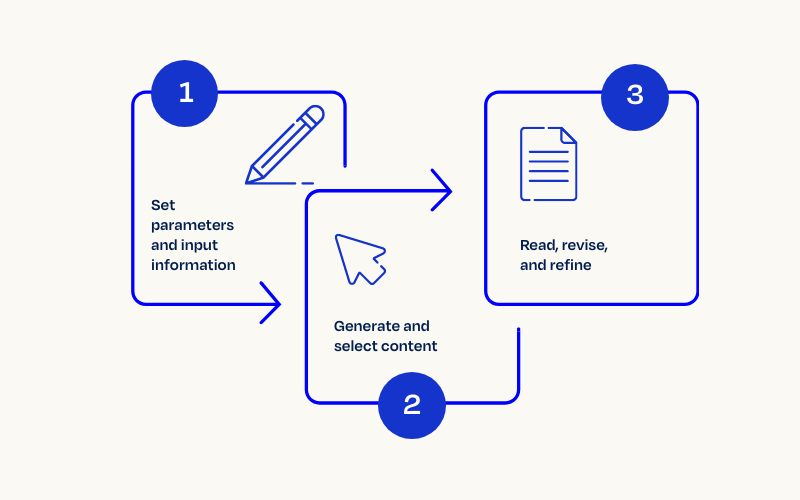
Now, where to start? There are countless generative AI tools out in the market today that can be leveraged as creative writing and design jump-off points. ChatGPT, from OpenAi, is a free (and increasingly popular) online conversation tool and language model that can be used for various applications including answering questions, writing content, text translation, topic research, or report generation. In the world of marketing, ChatGPT can aid in writing content and blog posts, creating brand messaging, and even name ideation.
Jasper is another AI copywriting tool that is particularly great for headline ideation and social media content writing. Jasper also enables you to experiment with different messaging and see what copy resonates the best with your audience. Jasper has a browser extension that allows the model to help improve and create tailored content for your brand, anywhere you are working online. Similar to ChatGPT, Jasper works based on prompts. You can choose between utilizing pre-made templates or open-ended commands in order to guide the model to produce content output you’re looking for.
Here’s a quick example of what using one of these copywriting tools (ChatGPT) for help with a naming project may look like:
- Building your prompt: First, you’ll want to provide ChatGBT with some relevant information about your brand or product so it can understand the context of your request. Start by defining your brand or product in a few simple sentences and provide ChatGPT with some related keywords and key differentiating factors. Then, ask ChatGPT to generate name ideas for your brand or product based on the information and keywords you provided.
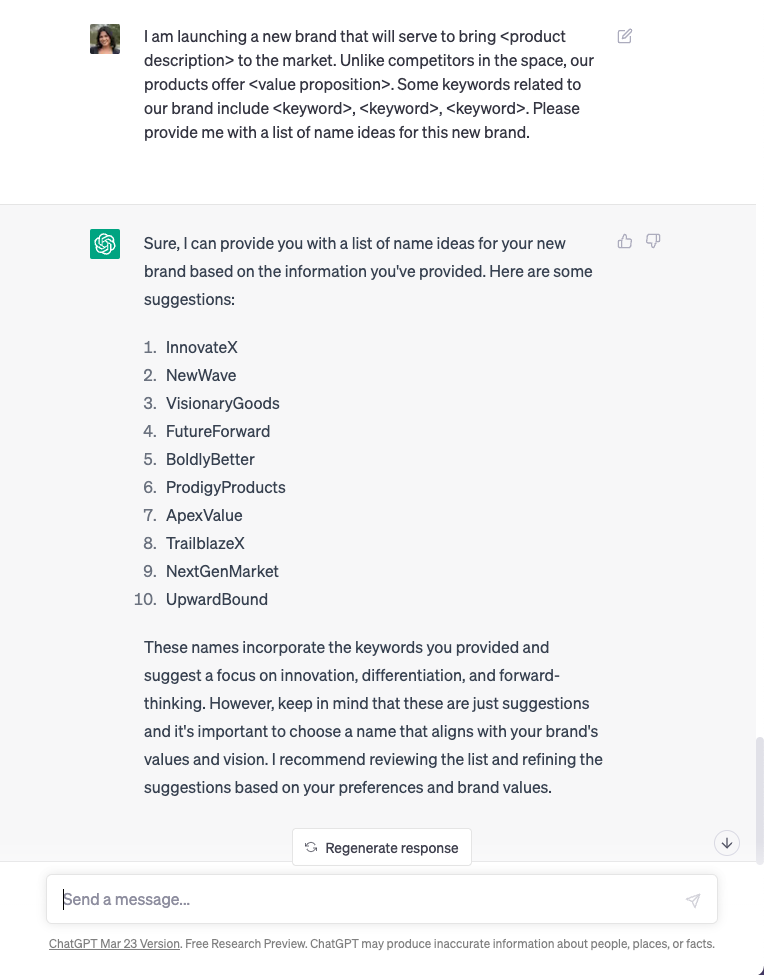
- Refining the output: After ChatGPT generates a list of name ideas, review the suggestions and refine them based on your preferences, brand values, or market trends. Remember that A.I. is based on machine learning, which takes feedback data to generate more content similar to the positive outputs and less like the content with negative outputs. Much like training a dog, you must make it clear what outputs you want to positively or negatively reinforce to shape the desired behavior. And ultimately, practice makes perfect. The more inputs and feedback you provide, the more data A.I. tools collect and leverage to improve their outputs. ChatGPT will generate more suggestions based on the refined criteria, and repeat the cycle until you see a name that fits your vision or sparks new ideas of your own.

Much like copywriting, there are several design and visual-focused generative AI products available to marketers and creatives alike. In addition to ChatGPT, OpenAI has also created an AI model focused on visual output. Named DALL·E 2, this model can transform natural language descriptions (or prompts) into realistic images and art. Two other popular text-to-image models include Stable Diffusion and Midjourney, the latter of which was recently leveraged by Bluetext on a client project.
Generative AI Takeaways
Because generative AI is not a perfect technology, in order to get the most out of these tools, it is essential to understand their strengths and limitations.

Some of the main benefits of generative AI include:
- Creativity & Exploration: Generative AI tools have the ability to generate novel and creative outputs that can be used for a wide range of marketing purposes. They can explore new ideas and insights that may not have been discovered through traditional methods.
- Efficiency: Generative AI tools can automate tasks that would otherwise be time-consuming or difficult for humans to perform, such as generating complex visual or written content.
- Personalization: Generative AI tools can create customized outputs based on specific inputs or user preferences, which can be used to create personalized products or services.
In contrast, generative AI tools have several limitations and concerns, some of which are:
- Output Bias: Generative AI tools can amplify biases present in the training data, leading to outputs that reflect societal or cultural biases.
- Limited Control: Generative AI tools can sometimes generate outputs that are difficult to control, leading to unpredictable or undesirable results.
- Contextual Understanding: Generative AI models cannot comprehend the nuances of human language, emotions, or cultural references, which can result in inappropriate or nonsensical output.
- Intellectual Property: Ownership and copyright of content generated by these tools is unclear, leading to potential legal challenges.

Actual or A.I.? This image of the Pope sporting a Blenciaga puffer jacket went viral as an example of A.I.’s powerful potential to trick viewers.
In conclusion, the potential of generative AI tools is vast and can have a transformative impact on creative processes. However, it is important to acknowledge AI’s imperfections. Keep in mind at the crux of A.I. is machine learning, meaning the technology is always learning, digesting more data to refine its ability and improve outcomes. The more practice and use these tools get the better the ultimate result. Creatives and marketers should approach their use with realistic expectations and carefully consider their application in specific contexts, but embrace the possibilities and inspiration the technology offers with open arms. And remember – there is a certain level of human input that will always be required to make creative visions come to life.
For a top marketing agency, trade shows are essential events to attend to learn all the tricks of the trade. It is usually a one time a year event where all the major industry players convene to learn about new products, network and promote their brands. It brings back old notions of experiential event marketing, but in 2020, brands are adding a digital twist. Now more than ever, companies are pairing their physical trade show presence with huge digital thumbprints, from hyper-targeted ads to Micro-Moments.
National Retail Federation (NRF) and their annual Big Show is a great example of how to do a trade show right. NRF’s Big Show is the largest retail conference and expo event, gathering over 40,000 attendees and 18,000 retailers from over 99 countries under one roof. Big Show capitalizes on Micro-Moments both before and during the show. By analyzing these tactics, we can learn how important Micro-Moments are for users and how to properly utilize them.

So what is a Micro-Moment? A Micro-Moment is an intent rich moment when an attendee uses their device to act on a need, including to know, to go, and to buy. The brilliance behind micro-moment marketing is that in the world today, consumers are bombarded by content everywhere they turn. Inc.com says the industry has reached a point of “content shock” where consumers are oversaturated and cannot consume any more content than they already are. Consumers spend an average of 4.7 hours each day on their smartphones, continually distracted and overstimulated. This only escalates the challenges marketers face to achieve consumers’ attention.

To combat the new challenges encountered with fragmented media interactions, top digital marketers have adopted a new mentality. This new philosophy zeroes in on distinct moments in the consumer buying process. The I-want-to-know moment, the I-want-to-buy moment and even the I-want-to-go moments.
Before the Show, NRF was strategic in focusing on the Micro-Moments of their target audiences’ “I-want-to-know” and “I-want-to-buy” moments through the use of various paid media tactics. Through the use of paid social, NRF increased brand awareness and utilized the “I-want-to-know” moment of users. Before driving users to register for the event, it’s crucial to make them aware of the brand, educating them about the event, as well as driving upper funnel traffic down the line. Paid display is where lower funnel traffic acts upon the “I-want-to-buy” moment. Paid display not only helps to generate qualified leads but also drives registrants.

During the Show, the various speakers and topics expanded upon Micro-Moments as well. A huge focus of sessions was on how to drive better experiences, better content and better strategy for consumers. There are various innovative technologies and solutions companies can utilize, as seen in the Innovation Lab and Startup Zone, that can help improve the user experience for customers in every stage of their individual Micro-Moments. Opening speaker, Satya Nadella, CEO of Microsoft, expanded upon this during his keynote session on the first day of the show. Nadella focused on how companies need to focus on the future of the retail industry, upcoming trends and how to utilize technology to transform how companies operate, are marketed and relate to consumers. By doing so, these Micro-Moments for users will be more memorable and excite consumers to change from “I-want-to-know” to “I-want-to-buy.” To see the full list of speakers, visit the NRF Speakers Page and check out the NRF Big Show 2020 recap for a full list of articles, videos, session presentations and more.
A key takeaway from NRF’s Big Show 2020 was the importance of personalizing and concentrating the customer experience in the digital era. Staying true to the NRF Vision, the National Retail Federation has acted as the eyes and ears of the retail industry. For over 100 years they have brought together important leaders from top retail companies and are the only organization committed to bringing critical foresight and insight to leaders, movers and makers.

Leading by example is an understatement, as the organization itself has been ahead of the curve in their paid media tactics and lead generation strategy. To learn more about the NRF media strategy, check out their Bluetext Hall of Fame.
With the start of the new decade, the digital marketing industry is abuzz with anticipation for 2020. Top interactive agencies are predicting big shifts in the upcoming year, in everything from engagement tactics to design and user experience. Bluetext, as one of Washington DC’s leading digital marketing agencies, has some 2020 predictions of our own.
In the upcoming year, trends in technology will alter and enhance how the world interacts with various media. Top interactive agencies are predicting massive growth in virtual reality digital marketing. The future will be filled with smart devices delivering increasingly insightful and interactive digital experiences. Recent innovations have allowed marketers to blend digital and physical realms to create an immersive world. Technology will enable expanded connections between sets of people, businesses, devices, content and services.
A top technology trend of 2020 will be virtual reality (VR) and augmented reality (AR). Virtual reality refers to any type of experience that places the user “in” another world or dimension. Augmented reality is a term for essentially placing virtual content “into” the real world by way of, for instance, your camera on your iPhone or an app. The most popular example of this is Pokémon Go.
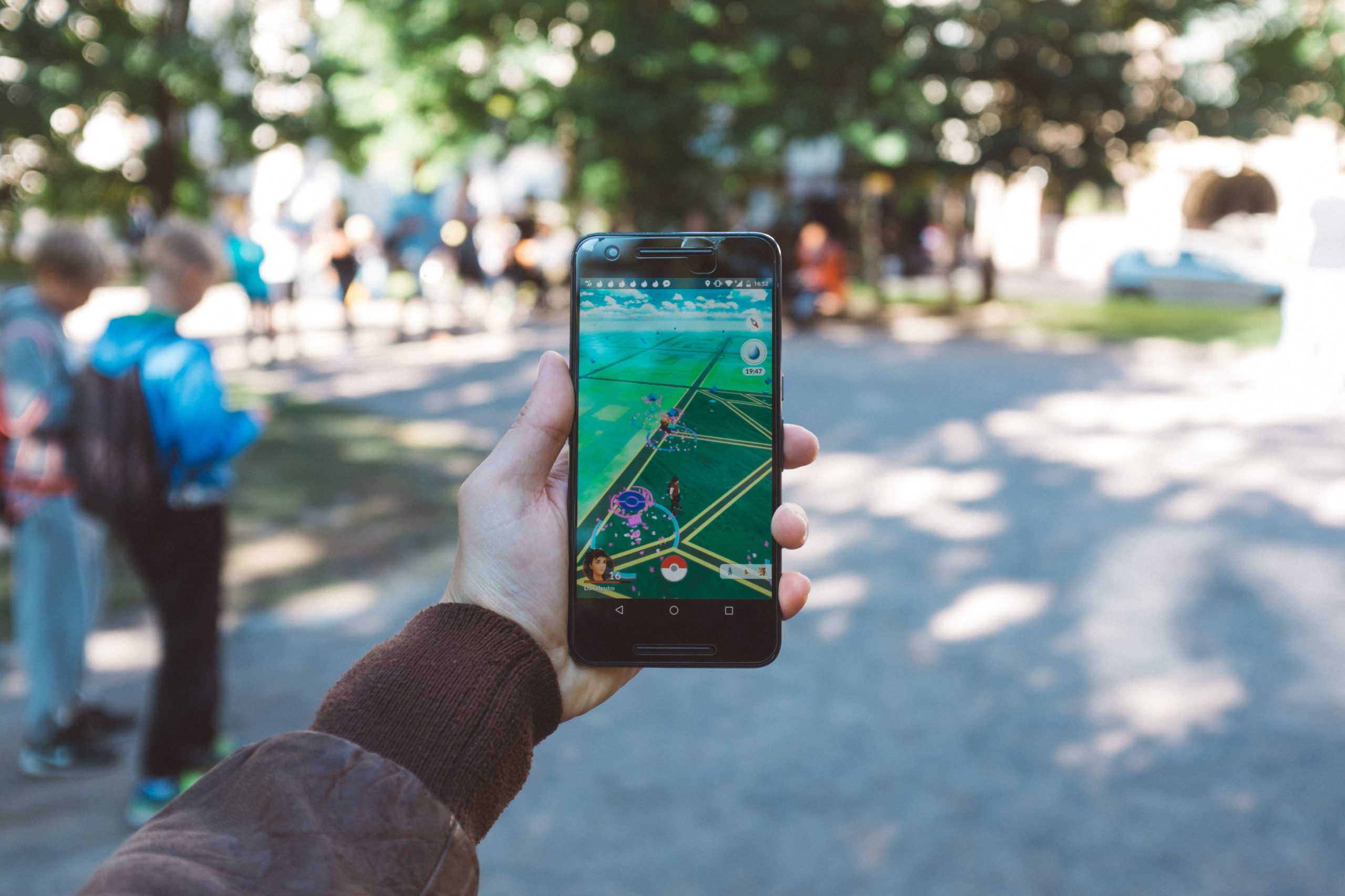
Top interactive agencies have been demonstrating the power of VR to change how users perceive the world and creating a truly immersive experience. Virtual reality production companies are expecting the next generation of VR to be able to sense shapes and track a user’s position and mixed reality (augmented and virtual) will enable consumers to view and interact with the world.
Virtual and augmented reality have been around for years, however, many companies were hesitant to adopt due to a poor user experience. Through recent tech improvements and growing expertise of user experience & interface companies, such as Bluetext, AR and VR are expected to grow quickly. In the next two years, Gartner predicts “70% of enterprises will be experimenting with immersive technologies for consumer and enterprise use.” Google cardboard glasses are a popular —and inexpensive—method to distribute the virtual reality digital marketing experience. 
A number of companies have already deployed innovative AR and VR experiences, especially in the B2C realm. Companies such as Sephora and IKEA are using augmented reality to allow consumers to preview and test products. While AR and VR lend well to the “try before you buy” sales strategy with enticing previews to persuade a final purchase decision, it has also been used in campaigns to turn heads. Burger King unveiled an AR experience that quite literally burned away the competitor. The fast-food chain encouraged app users to scan competitors’ ads, which would activate an augmented reality experience. As the competitor’s ad combusted, it was replaced with a Burger King ad and directed to the nearest restaurant to claim a free Whopper.
Top virtual reality digital marketing experts will tell you this tech trend is sweeping a variety of industries as a method of differentiation. Especially in the B2B market, virtual reality has proven to be an incredibly powerful marketing tool to help close a sale and drive conversion. A virtual reality experience can go in-depth to product specs and prove exactly why it’s superior. When designed by a top virtual reality video production company the experience can be like a trade show, a sales demo, and a marketing presentation in one. Industries like cybersecurity or manufacturing can truly benefit from immersive experiences. When products are shown through virtual reality, the viewer can demo a complex product with ease. Top virtual reality video production companies also stress the importance of standing out in saturated markets and hectic trade shows.
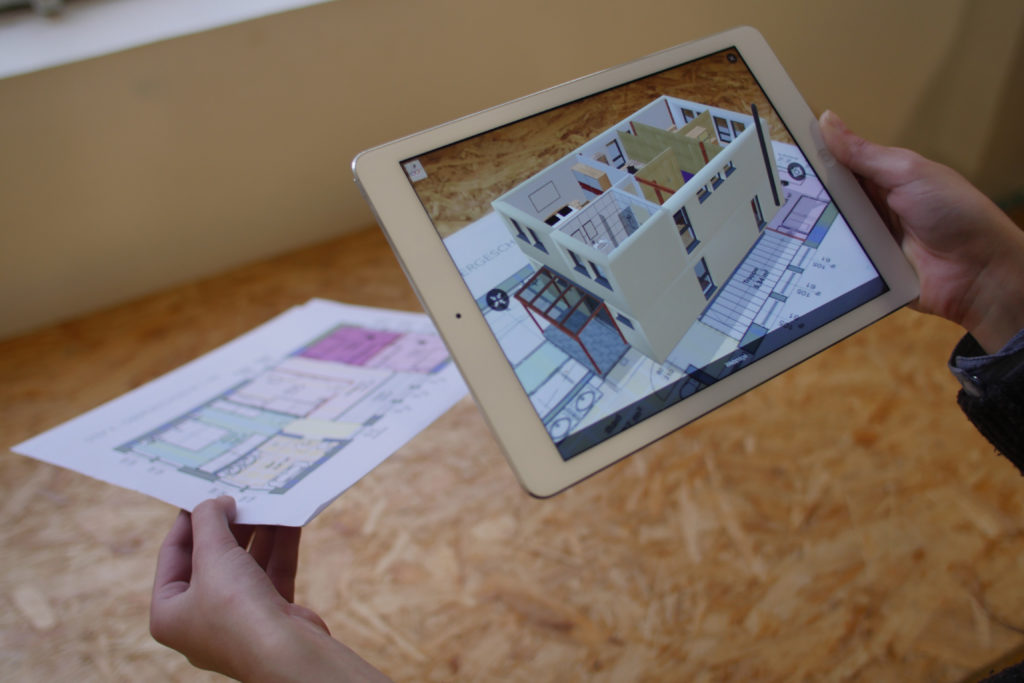
An effective and memorable AR or VR experience is an opportunity to capture physical attention and convert that to digital action. Interested in differentiating your company with next-generation digital tactics? Learn how Bluetext can bring your video and virtual reality ideas to life.
 Optimize Often
Optimize Often
